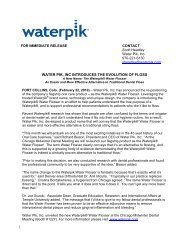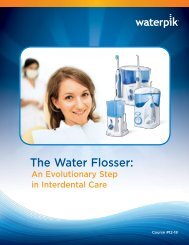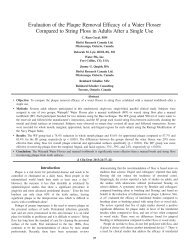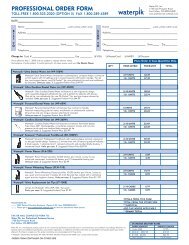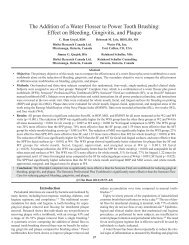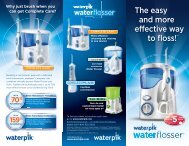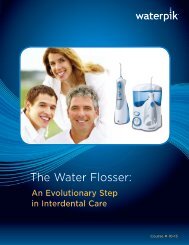Seniors and Boomers: Living Longer, Living Healthier ... - Waterpik
Seniors and Boomers: Living Longer, Living Healthier ... - Waterpik
Seniors and Boomers: Living Longer, Living Healthier ... - Waterpik
You also want an ePaper? Increase the reach of your titles
YUMPU automatically turns print PDFs into web optimized ePapers that Google loves.
glycemic control to be non-significant. The investigators noted<br />
that many confounding effects including smoking, BMI, <strong>and</strong> diet,<br />
play a role in glycemic control, <strong>and</strong> this may have had an influence<br />
on outcomes. 34<br />
Chronic Obstructive Pulmonary<br />
Diseases (COPD)<br />
The association between COPD <strong>and</strong> periodontal disease has not<br />
been studied extensively. A 2001 analysis of NHANES III data<br />
found that those with COPD were more likely to have periodontal<br />
attachment loss than those without COPD. The results also showed<br />
that those with the most attachment loss had a higher risk of<br />
COPD as well as diminished lung function. 35 However, 2003 <strong>and</strong><br />
2006 systematic reviews found a very weak association between<br />
periodontal disease <strong>and</strong> COPD. 31,36<br />
A stronger association has been found between periodontal<br />
disease <strong>and</strong> nosocomial (hospital- or institution-acquired)<br />
pneumonia, particularly in elderly people with poor oral hygiene. 31,36<br />
It is possible for plaque to be colonized by respiratory pathogens.<br />
Loss of immune function <strong>and</strong> the release of inflammatory<br />
cytokines may also play a role. 31 Oral health interventions ranging<br />
from tooth brushing to use of an antimicrobial have been shown to<br />
decrease the risk of lung infections. 36<br />
Oral Cancer<br />
Early detection improves the survival rate for people with oral cancer.<br />
A manual oral cancer exam only takes a few minutes to perform <strong>and</strong><br />
can easily become a regular part of every exam. New diagnostic aids<br />
may enhance the manual exam but are not a substitute for it.<br />
Abnormal tissue like leukoplakia <strong>and</strong> erythroplakia are almost always<br />
caused by smoking or spit tobacco. The tissue may range from being<br />
harmless to containing cancerous cells. Additional tests are the only<br />
way to confirm. About 25% of leukoplakias are either cancerous<br />
or precancerous. The rate for erythroplakia being cancerous or<br />
precancerous is 7 in 10. 22<br />
It is estimated that many cases of oral cancer could be prevented<br />
by avoiding tobacco <strong>and</strong> alcohol use. 22 Dental professionals can help<br />
support tobacco cessation by openly discussing the oral health effects<br />
of tobacco with patients. The emerging risk factor, HPV, generally<br />
shows no signs or symptoms upon being infected. 22 A new test to<br />
detect oral HPV may help identify individuals who are at an increased<br />
risk of developing oral cancer in the absence of other risk factors. 37<br />
Osteoporosis<br />
The association between osteoporosis <strong>and</strong> periodontal disease<br />
is not well-defined. Some studies have shown low bone mineral<br />
density to be associated with alveolar bone loss while others have<br />
not. 38,39 It has been hypothesized that this disparity in findings<br />
may be due to the presence of known osteoporotic risk factors<br />
including hormone action, heredity, <strong>and</strong> other host factors. 38<br />
Of more immediate concern has been the role that osteoporotic<br />
pharmaceuticals may have in osteonecrosis of the jaw (ONJ). In<br />
the last few years, cases of bisphosphonate-associated ONJ have<br />
been reported, particularly after invasive dental procedures such<br />
as an extraction. These cases have occurred in people with a<br />
history of intravenous bisphosphonate use related to the control of<br />
bone pain for various types of cancer. For oral bisphosphonates,<br />
the risk of ONJ is very low—approximately 0.7 cases per 100,000. 41<br />
Two studies released in 2008 are in alignment with this. One<br />
found that IV but not oral bisphosphonate use was associated<br />
with an increased risk for ONJ. 41 The second found ONJ rare in<br />
postmenopausal women with osteoporosis. 42 However, a 2009<br />
case study found that the short-term oral use of bisphosphonates<br />
increased the risk of ONJ in older women who had been taking a<br />
bisphosphonate for 12 months or more. All occurred after either<br />
an extraction or trauma that resulted in jaw bone exposure. Those<br />
who were affected had additional chronic conditions like diabetes,<br />
hypertension, or cancer treatments. 43<br />
Dementia <strong>and</strong> Disabilities<br />
The biggest challenge facing many people suffering from dementia<br />
or disabilities is the ability to seek care within a traditional dental<br />
setting. Depending on the nature or depth of the problems,<br />
many older individuals no longer drive <strong>and</strong> depend on caregivers<br />
to transport them to appointments. For those with advanced<br />
dementia, leaving home may not be feasible. Some may no longer<br />
be able to perform simple oral hygiene procedures. Many longterm<br />
care facilities are not able to provide adequate or regular<br />
access on-site for dental care. In addition, upon retirement, most<br />
individuals lose coverage for dental insurance, <strong>and</strong> Medicare does<br />
not reimburse for most dental services.<br />
People with functional disabilities or sensory disabilities may still be<br />
able to seek care in the traditional practice setting. Greater use of<br />
mobile carts <strong>and</strong> improved designs in canes <strong>and</strong> walkers are helping<br />
people stay mobile. Practitioners should anticipate that these<br />
individuals may need more time <strong>and</strong> assistance when they come<br />
for appointments. Some patients who do not appear disabled may<br />
have arthritis in their h<strong>and</strong>s, which can result in difficulty performing<br />
routine oral hygiene procedures, especially flossing.<br />
Vision <strong>and</strong> hearing loss can also impact care. Patients may not<br />
have the visual acuity to see oral health problems that are found.<br />
For patients with hearing impairment, taking off the mask <strong>and</strong><br />
establishing eye-to-eye contact can be helpful. People with hearing<br />
loss are often embarrassed <strong>and</strong> may not admit they cannot hear.<br />
Xerostomia<br />
Xerostomia has been reported to affect anywhere from 29%–57%<br />
of older individuals. 32 Medication use is one of the primary<br />
culprits. It is a side effect in hundreds of medications. Seventy-six<br />
percent of adults over 65 were reported to have taken at least<br />
two prescription drugs per month while nearly 37% used five or<br />
more. The most commonly prescribed medication for those over<br />
65 is a cholesterol-lowering drug followed by high blood pressure<br />
medications. 44 Chronic conditions including Sjogren’s syndrome,<br />
thyroid disease, <strong>and</strong> poorly controlled diabetes are also factors in<br />
xerostomia. 45 7




